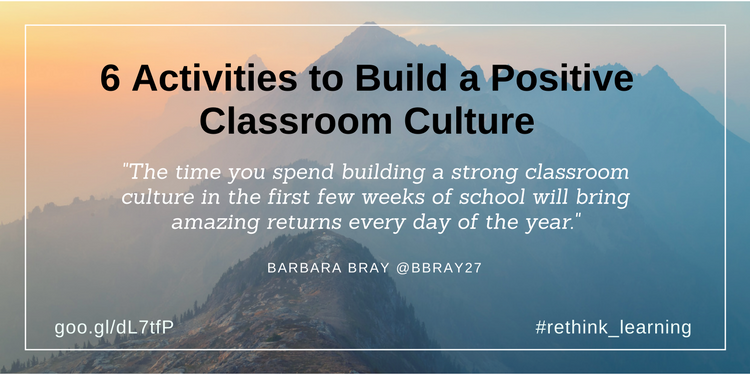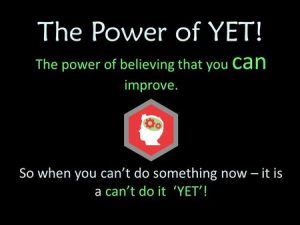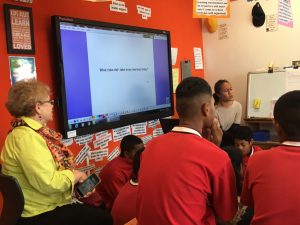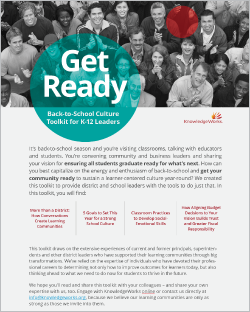
Every school is unique and has its own demographics and issues. Every learner comes to school with their strengths, challenges, background, and concerns. In fact, each class is unique because of the teacher and how they present what it means to be part of the class. One way to build the culture is to start the year by getting to know each other. The time you spend building a strong classroom culture in the first few weeks of school will bring amazing returns every day of the year. You can build a compassionate classroom and place relationships at the center of the classroom that are based on trust and respect. Relationships matter! So how do you build trust and a caring classroom?
Our first questions should be, “What do children need?”…
followed immediately by “How can we meet those needs?” Alfie Kohn
Culture Building Activities
Here are a few culture building activities for any age learners to build a positive classroom culture where they get to know and care about the teacher and each other.
1. Welcome Message
What message does your classroom give right when people walk in? What about creating a welcome sign? The picture on the left has a message that you can make personal to represent the culture in your class. The welcome sign doesn’t have to be a sign; it can be a poster or a welcome mat. The idea is to make your classroom inviting to anyone who wants to learn or visit your class.
2. Special Greetings
Instead of jumping right into academics as soon as your learners come in the door, what about coming up with a special greeting just for your class? Some teachers even have special handshakes. You don’t have to memorize a special handshake for each learner, but please memorize their names. Find a way to make each learner unique and valued for who they are. Do some homework to find out something each learner is passionate about or some event they were involved in. When you greet each learner, look them in the eye, say their name, and mention something or ask a question about them, it makes a difference. I saw this video from the Atlanta Speech School on Facebook and felt it just had to be shared here also.
3. Morning Meetings
 A compassionate classroom is also a responsive community. A morning meeting is an engaging way to start each day and to focus on social-emotional learning using strategies to foster a sense of belonging and caring. The teacher can start off the year defining empathy and model how to do active listening. Learners can sit in a circle and greet each other. The teacher can invite learners to pair with someone they haven’t shared with before. Then have them ask each other questions about something important in their lives. The teacher can then bring everyone back and start the day with an activity or question to think about during the day. One question could be “How will you reflect on your learning today?”
A compassionate classroom is also a responsive community. A morning meeting is an engaging way to start each day and to focus on social-emotional learning using strategies to foster a sense of belonging and caring. The teacher can start off the year defining empathy and model how to do active listening. Learners can sit in a circle and greet each other. The teacher can invite learners to pair with someone they haven’t shared with before. Then have them ask each other questions about something important in their lives. The teacher can then bring everyone back and start the day with an activity or question to think about during the day. One question could be “How will you reflect on your learning today?”
4. The Power of YET
 Start the year by reviewing the words we say and what they mean. In a previous post, 7 Ideas to Discover Magic in Your Classroom, I mentioned fixed vs. growth mindset. After meeting with some teachers and learners, I saw the emphasis on using the word: YET. Start off the year talking about mindset and the words that demonstrate a fixed mindset and how changing the words and statements so they demonstrate a growth mindset. But we are humans and creatures of habits. We tend to go back to saying “I can’t..” and “I’m not…” Share the word YET and see the power of it. Say it over and over until your learners use it all on their own and maybe even to correct you.
Start the year by reviewing the words we say and what they mean. In a previous post, 7 Ideas to Discover Magic in Your Classroom, I mentioned fixed vs. growth mindset. After meeting with some teachers and learners, I saw the emphasis on using the word: YET. Start off the year talking about mindset and the words that demonstrate a fixed mindset and how changing the words and statements so they demonstrate a growth mindset. But we are humans and creatures of habits. We tend to go back to saying “I can’t..” and “I’m not…” Share the word YET and see the power of it. Say it over and over until your learners use it all on their own and maybe even to correct you.
5. Me Too Activity
 Have learners share something about themselves and what they like to do such as “I like Minecraft.” If other learners also like Minecraft, they then stand up and say “Me too!” Continue to invite learners to share something and see who else has the same interests or facts. Then give them time to share with each other. If they enjoy tinkering, designing, and building, invite them to put together a proposal on what they would like to create together. Have them share with another group for feedback. This Me Too activity can be used for anything that learners may want to do together.
Have learners share something about themselves and what they like to do such as “I like Minecraft.” If other learners also like Minecraft, they then stand up and say “Me too!” Continue to invite learners to share something and see who else has the same interests or facts. Then give them time to share with each other. If they enjoy tinkering, designing, and building, invite them to put together a proposal on what they would like to create together. Have them share with another group for feedback. This Me Too activity can be used for anything that learners may want to do together.
6. Reflections
 Put time aside at the end of the day or period for reflection. Come up with a question for learners to consider for reflection. A question could be about “What did you do to take a risk today in your learning?” I saw learners doing this reflection at Viscount Primary School in Mangere district of Auckland . It was very powerful to listen to the discussions they had with another learner about the risks they took. Then the teacher invited all learners to sit in a circle and share any thoughts about their reflections. It was so cool that everyone wanted to share. You could see a real compassionate classroom where everyone cared about each other.
Put time aside at the end of the day or period for reflection. Come up with a question for learners to consider for reflection. A question could be about “What did you do to take a risk today in your learning?” I saw learners doing this reflection at Viscount Primary School in Mangere district of Auckland . It was very powerful to listen to the discussions they had with another learner about the risks they took. Then the teacher invited all learners to sit in a circle and share any thoughts about their reflections. It was so cool that everyone wanted to share. You could see a real compassionate classroom where everyone cared about each other.
You may find that building a culture is bigger than just one classroom; it involves the whole school. Check out the resources put together by KnowledgeWorks to help you build a positive culture.
Back to School Culture
Download KnowledgeWorks Get Ready: Back-to-School Culture Toolkit to uncover insights from other district and school leaders on:
- How to engage parents, community members, and business leaders
• 5 goals to set for a strong school culture
• Tips for helping students develop critical social-emotional skills needed for the future workforce
• Guidance on aligning budget decisions to your learner-centered vision
*****
Interested in checking out more of the Rethinking Learning podcasts and reflections, click on the podcast tab at the top, the logo below, or go to https://barbarabray.net/podcasts/
For more information about Barbara’s book, Define Your WHY, go to this page or click on the image of the book for resources, questions, and links.






